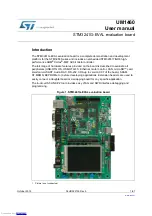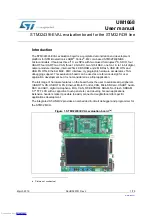
http://www.tyan.com
165
RAID (Redundant Array of Independent Disks):
a way for the same data to be
stored in different places on many hard drives. By using this method, the data is
stored redundantly and multiple hard drives will appear as a single drive to the
operating system. RAID level 0 is known as striping, where data is striped (or
overlapped) across multiple hard drives, but offers no fault-tolerance. RAID level 1
is known as mirroring, which stores the data within at least two hard drives, but
does not stripe. RAID level 1 also allows for faster access time and fault-tolerance,
since either hard drive can be read at the same time. RAID level 0+1 is striping and
mirroring, providing fault-tolerance, striping, and faster access all at the same time.
RAIDIOS:
RAID I/O Steering (Intel)
RAM (Random Access Memory):
technically refers to a type of memory where
any byte can be accessed without touching the adjacent data and is often referred
to the system’s main memory. This memory is available to any program running on
the computer.
ROM (Read-Only Memory):
a storage chip which contains the BIOS; the basic
instructions required to boot the computer and start up the operating system.
SDRAM (Synchronous Dynamic RAM):
called as such because it can keep two
sets of memory addresses open simultaneously. By transferring data alternately
from one set of addresses and then the other, SDRAM cuts down on the delays
associated with non-synchronous RAM, which must close one address bank before
opening the next.
Serial port:
called as such because it transmits the eight bits of a byte of data
along one wire, and receives data on another single wire (that is, the data is
transmitted in serial form, one bit after another).
SCSI Interrupt Steering Logic (SISL):
Architecture that allows a RAID controller,
such as AcceleRAID 150, 200 or 250, to implement RAID on a system board-
embedded SCSI bus or a set of SCSI busses. SISL: SCSI Interrupt Steering Logic
(LSI) (only on LSI SCSI boards)
Sleep/Suspend mode:
in this mode, all devices except the CPU shut down.
SDRAM (Static RAM):
unlike DRAM, this type of RAM does not need to be
refreshed in order to prevent data loss. Thus, it is faster and more expensive.
SLI (Scalable Link Interface)
: NVIDIA SLI
technology
links two
graphics cards
together to provide scalability and increased performance. NVIDIA SLI takes
advantage of the increased
bandwidth
of the
PCI Express
bus architecture, and
features
hardware
and
software
innovations within NVIDIA
GPU
s (graphics
processing units) and NVIDIA MCPs (media and
communications
processors).
Depending on the
application
, NVIDIA SLI can deliver as much as two times the
performance of a single GPU configuration.
Summary of Contents for TYAN S7103
Page 2: ...http www tyan com 2 ...
Page 23: ...http www tyan com 23 2 2 Block Diagram S7103 Block Diagram ...
Page 24: ...http www tyan com 24 2 3 Mainboard Mechanical Drawing ...
Page 51: ...http www tyan com 51 3 3 1 1 Add an Attempt Read only NOTE Only LAN1 supports iSCSI function ...
Page 61: ...http www tyan com 61 3 3 2 1 1 1 1 Volume0 RAID0 Stripe 708 0GB Normal Read only ...
Page 69: ...http www tyan com 69 3 3 7 AST2500 Super IO Configuration Super IO Chip Read only ...
Page 98: ...http www tyan com 98 3 4 3 Server ME Configuration Read only ...
Page 103: ...http www tyan com 103 Numa Enable or Disable Non uniform Memory Access NUMA Disabled Enabled ...
Page 105: ...http www tyan com 105 3 5 3 1 UPI Status Read only ...
Page 107: ...http www tyan com 107 3 5 4 1 Memory Topology Read only ...
Page 122: ...http www tyan com 122 3 5 5 4 Intel VMD Technology ...
Page 148: ...http www tyan com 148 NOTE ...
Page 158: ...http www tyan com 158 BIOS Temp Sensor Name Explanation ...
Page 159: ...http www tyan com 159 ...



































